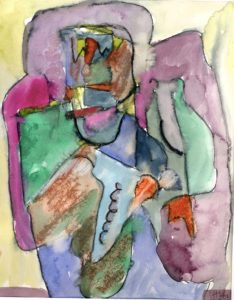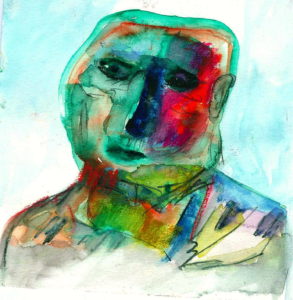Dr. T. and his patient C.R.
edited story
Liz Wheeler, Esq.says, “I’m confused. Nothing is what it seems, whatever that means.” Her colleague, Larry Stone, Esq. responds, “I agree. I guess we have to continue to be confused.”
As you walk into the lobby of the Collins Professional Building, there is a huge display on the wall. It is made up of colorful variants of the earth spinning in space. Beneath the display, in bold purple letters, are the words ‘At the Collins Professional Building, you will find a world of experts ready to serve you.’
The office spaces in the building are devoted to the practice of law, accounting practices, travel agencies, real estate developers, human engineers, financial institutions, and medical offices, which occupy the first to third floors of Collins. One suite was the psychiatric practice of Dr. T. It has been empty for several months.
Larry Stone and his friend and colleague Liz Wheeler were lawyers in the large law firm of Stanley, Roman, and Allison. It was a law firm that specialized in commercial law. Larry and Liz would often take a break in the Café Collins, at the rear of the lobby. They talked about all sorts of things, including their unhappy marital life and their wonderful elementary-age kids. They commiserated with each other’s plight. They talked and at one point flirted with the idea of an affair but Liz thought…no … .let’s stick to talking, and support and …so now what?
Larry asked Liz, what do you make of the disappearance of our resident shrink, Dr. T.
Liz shook her head, smiled, and told Larry about her past conversations with Dr. T. “Larry, I got to know the guy, kind of. He was a charming old oddball with an infectious smile. I was having a cup of coffee and he sat down at my table. He said “Do you mind?” and I said, “No problem”. He then asked me “Aren’t you a lawyer, a lawyer with Stanley, Roman, and Allison?” I said yes and then he went on. “My name is Dr. T and I need a lawyer. The state medical review board is about to revoke my license to practice medicine. Those dumb gangsters have nothing better to do than hunt down an old therapist. You’re a lawyer and so maybe you can help me.” I told him I do commercial law and not the kind that would be of help to him.”
Yes, an oddball for sure but seemed so vulnerable, quietly desperate. He didn’t say anything. Just sat across from me and … get this…he was chewing and popping bubble gum. When I looked surprised at another bubble bursting he told me he got the idea of chewing bubble gum from watching baseball managers chew bubble gum and sunflower seeds to keep their tension in check. He went on and started to tell me, a total stranger, about his recent life. His wife died 2 years ago, no kids, few friends, and adrift hurting. It seemed to me that while his patients talked to him about their lives and pain he had no one to talk to. I felt bad for him and realized that talking to me even for a few minutes was helpful. He got up and saw him slowly walk away towards his office. Larry, even the way he dressed was odd. Blue blazer, heavy turtle neck black sweater, and a Yankees baseball cap perched on his head. Saw him several other times at the café after this. He always seemed to enjoy talking to me, since he always left with a hint of a smile and a wave of his hand, like that of a child leaving to get to the school bus.
The last time I saw him he left this story behind, clearly on purpose.
A Dr. T story
It was inevitable that it would come to this. The state medical review board will meet and decide whether to rescind Dr. T’s medical license to practice medicine in New York State. Preliminary review seems to indicate that Dr. T’s clinical judgment and practices are impaired. A final evaluation of Dr. T’s medical records will be completed by the end of September 2024.
One of Dr. T’s colleagues told the medical review committee that Dr. T had read a paper in Biological Psychiatry that he thought was worthy of a Nobel Prize. He was so impressed that he read the paper three times so as not to miss anything or misconstrue the implications of the findings. The paper reported on a study on the neural foundations of subjective pain. Dr. T said that in the article the authors could show that emotional pain is real pain. They both activate the same brain circuitry. For example, the pain we experience following rejection by someone we love is much like our brain’s response to physical pain conditions like touching a hot stove. Describing the pain associated with a lost relationship is not just a metaphor but also a real (neural) thing. Much of what Dr. T said about the article made sense but then he jumped to conclusions that were simply absurd. Based on that paper he started prescribing Advil along with nootropics for many of his patients who were suffering emotionally. Dr. T thought that a drug administered to reduce the experience of ‘real’ pain should suppress the effects on the neural circuitry that is involved in emotional pain.
Dr. T also read a paper that showed that different types of fear activate different neural circuitry. That gave him the idea to treat different types of fear (and anxiety) differently. He planned to work on that project starting with inducing different forms of fear and anxiety in normal volunteers. However, he needs a collaborator who is an expert in neurochemistry.
The medical review board was left speechless on hearing of Dr. T’s treatment plans. The board reviewed all sorts of material relating to Dr. T’s practice including copies of case study notes. An example of some of these notes is summarized in one therapy session of Dr. T’s treatment of C.R
More of the Story
The patient C.R. sat in Dr. T’s waiting room. He had arrived 30 minutes before his scheduled appointment. He sat skimming through old copies of Time magazine and copies of last week’s newspaper.
He had already eaten two Payday candy bars. C. R. left the empty candy wrappers on the floor in front of him. He had opened a third Payday candy bar when the door of D.T.’s waiting room opened. A young woman came running out of Dr. T’s treatment office. She was tugging at her skirt and straightening her blouse. She yelled back over her shoulder, No. No. Never. I’m not coming back ever, ever. She then disappeared out the door of the waiting room.
Dr. T shouted. The door is open. Come on in. And so, the action begins. Hold on and if not don’t. Always a fast flight from somewhere to somewhere else.
Dr. T. sits slouched in his armchair, silent, staring at a vase just behind the shoulder of his patient C.R. The room is silent and in a shadowy light. There is a cat on his lap that is purring quietly. Dr. T puts on a Yankee baseball cap.
Minutes pass. C.R. clears his throat, “Well Doc, I think I am making some progress but I have to tell you, well, I was trying to understand what you were telling me last week, and you know, it was a hard going but I think I got it. Tricky stuff. You wanted it to be hard for me to follow what you were saying because if it were easy it would not help me. I had to work hard to understand what you told me. You said it was important that I pay attention to your words. You were so right. Anyway, I left your office. I had a breakthrough or maybe a break-in. Maybe if I tried harder I could be like everyone else. I’ll try harder.”
C.R went on to say “This week I noticed the voices were not as loud as they used to be, more like a whisper, and since last week most of the time, I don’t do what they tell me to do. And one more thing, the voices don’t interrupt me when I am thinking especially when it is important like my grocery shopping list. The voices also tell me they like me. Yesterday they even told me a joke that made me laugh.”
Dr. T. interrupted “Yes, good, I know, but for now just Shhhhhhhh. Let’s go back to where we were, where we were then, not now when I was telling you about lufoooto astorovo nickmara, nostonia.”
C.R. bolted upright and moved to the front of his chair, staring at the Doctor. C.R. I was puzzled.
“I don’t understand. I don’t get it. Just like last week and I asked you then, I remember asking you about what language, or maybe special code you were using to talk to me. So, then I thought that I should wait a minute or an hour and then I got it. I figured out that you were asking me a trick question or you were trying to test me whether I could come up with a really important answer.
Dr. T replied very slowly, “Fuk mar, fuk mar now and forever”
C.R. hesitated then asked, “What is fuk mar, what is it? It sounds like fuck more but I know you didn’t mean that.”
Dr. T looks disappointed, “No, I said fuk mar, fuk mar. “
C.R. responded. “Wait a minute, I get it. I think you are saying fuck you. But why are you saying that to me? Maybe,…wait I got it. You are saying fuk mar to tell the voices, my voices to shut up. To protect me you are telling my voices to fuck off in a language they understand.”
The cat on Dr. T’s lap jumped off and walked over to C.R. The cat jumped into C.R.’s lap. C. R. started to stroke the cat and the cat started purring. C.R. remarked, “Maybe your cat likes me better than you. Maybe he wants to be my friend. Maybe he understands me.”
Dr. T ignored what C.R. had said.
Finally, Dr. T replied, “Yes, fuk mar and forevel so that the dingle mok wins in doubles and if not go your own way. “
C.R. heard the words, and thought for a moment “I have to think about that some more. Yeah, I think I know what you mean, you mean, fuk mar. That is it. Doc, I think this is an important breakthrough. Don’t you?”
Dr. T I repeat. “Yes, fuk mar and forevel so that the dingle mok wins in doubles, and if not go your way.”
C.R. repeated what Dr. T had just said.
This story is just one of many examples based on notes from Dr. T’s treatment of patients.
Appeal
The Medical Review Board revoked Dr. T’s medical license. He appealed their decision. In support of his appeal to be reinstated, he pointed out that many of his patients had positive therapy outcomes including C.R. and the woman who he presumably groped during a therapy session. Dr. T provided evidence of many other therapeutic successes.
For example, the unnamed woman who had run from his office shouting “no, no, never coming back” had written Dr. T a note letting him know how much he helped her see herself in a new light. She no longer was simply an unattractive middle-aged depressed woman but someone who was attractive and desirable.
It turns out that the patient, C.R. has been doing reasonably well since leaving his therapy sessions with Dr. T. The amount of medication needed to control his psychosis has been reduced in half. He has been able to work part-time in the stockroom of Philip’s Furniture.
Magic moments? What turns out to affect changes in the functioning of patients with mental disorders or changes in any of us? To this point, Dr. T pointed out that the Medical Review Board is nothing more than a rubber stamp for failed therapeutic methods. It is an old boy’s club with its own worn-out language that is meaningless, and useless. The Review Board thanked Dr. T for his candor.
After thought
What’s true, real or a product of our imagination or knowledge we have that isn’t real knowledge at all? We give meaning to our experiences even if in reality we are dealing with nonsense or random events. We also generate our version of what is real and why things happen the way they do. That is we provide a structure for all our experiences. By the way, it has been shown that physical pain and emotional pain are based on the activity of the same neural networks.



